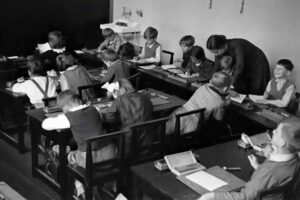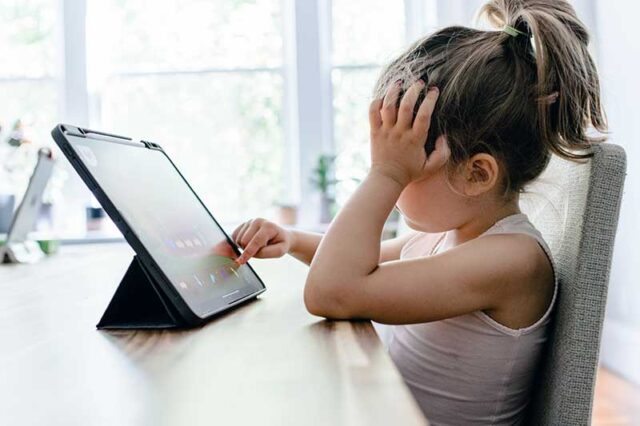Technology in the classroom has always been at the forefront of human education. Technology continues to push academic capabilities in the classroom to new ranges. In looking at where academic strategies and instruments have come from to the place, they’re going sooner or later. Technology’s significance in the classroom is obvious now greater than ever.
As we sail by the 21st century, technology in the classroom is changing into increasingly more predominant. Moreover tablets are changing our textbooks, and we can analyze absolutely anything that we wish to on our smartphones. Social media has to turn into commonplace. The best way we use technology in the classroom has utterly remodeled the best way we reside in our lives.
History of Technology in the Classroom: The Primitive Classroom
Within the Colonial years, picket paddles with printed classes, known as Horn-Books, were used to help college students study verses. Over 200 years later, in 1870, technology experts to incorporate the Magic Lantern. A primitive model of a slide projector that projected photographs printed on glass plates.

By the point World Conflict I ended, round 8,000 lantern slides had been circulating by the Chicago public college system. By the point, the Chalkboard got here round in 1890, adopted by the pencil in 1900. Also it was clear that college students had been hungry for extra superior academic instruments.
Radio within the 1920s sparked an entirely new wave of studying; on-air lessons started popping up for any scholar inside the listening vary.
Subsequent got the overhead projector in 1930, headphones in 1950, and adopted by the ballpoint pen in 1940.
Videotapes arrived in 1951, creating a brand new and thrilling methodology of instruction.
The Skinner Educating Machine produced a mixed system of educating and testing. It offers reinforcement for proper solutions so that the scholar can transfer on to the subsequent lesson.
The handheld calculator (1972) and photocopier (1959) entered the lecture rooms subsequent, permitting mass manufacturing of fabric on the fly and fast mathematical calculations.
The Scantron system of testing, launched by Michael Sokolski n 1972, allowed educators to grade tests more shortly and effectively.
The pre-computer years had been formative within the selections made for computer systems within the years following. Rapid response-type techniques (video, calculator, Scantron) had turned into essential. Fast manufacturing of educating supplies, utilizing the photocopier, had turned into a typical.
The Entrance and Significance of Personal Computer systems
Though the primary computer systems developed within the ’30s, everyday-use computer systems launched within the ’80s. The primary transportable laptop, in 1981, weighed 24 kilos and a price of $1,795.
When IBM launched its first private laptop in 1981, the academic world knew it was on the verge of greatness. Time journal named The Pc its “Man of the Yr” in 1982.
Time declared, “it’s the finish results of a technological revolution that has been within the making for 4 many years and is now, fairly actually, hitting residence.”
Toshiba launched its first mass-market client laptop computer in 1985 (the T1100), and Apple‘s notorious Mac (which later developed into the Powerbook) was available beginning in 1984.
In 1990, The World Web Net came to life when a British researcher-developed Hyper Textual content Markup Language or HTML, and when the Nationwide Science Basis (NSF) eliminated restrictions on the Web’s industrial use in 1993.
The world exploded right into a frenzy of newfound analysis and communication strategies.
Apple Pc Inc. had launched the primary Private Digital Assistants (PDAs) in 1993. With that, computer systems had been part of day-after-day, if not each second. By 2009, 97% of classrooms had several computer systems, and 93% of classroom computer systems had Web entry.
For each 5 college students, there was one laptop. Also instructors acknowledged that 40% of scholars used computer systems, usually of their academic strategies and interactive whiteboards and digital cameras. Faculty college students these days are not often without some laptop technology: 83% personal a laptop computer, and over 50% have a Smartphone.
The Future of Technology in the Classroom
It looks as if years since MySpace, first launched in 2003, Fb (2004), and Twitter (2007) have modified each the communication and enterprise worlds. On the spot, connectivity has branched out from merely an instrument of private communication to a platform for academic instruction and outreach.
Social media is now acknowledged as an accepted type of instruction in some situations, and teams resembling Scholastic Academics present glorious assist and suggestions for instructors.
Many instructors use social media to speak straight with their college students or kind forum-style teams for college kids to speak with one another. The strategy appears to be proving beneficial in offering one-on-one consideration to scholar’s questions and issues.
Future Classrooms
With the classroom having already developed right into a hotbed of technological advances, what can the more extended term probably maintain that would require additional academic proficiencies much more?
Biometrics, a technology in the classroom that acknowledges individuals primarily based on certain bodily or behavioral traits, is on the technological horizon.
The science used to acknowledge scholars’ bodily and emotional disposition in the classroom, altering course materials to tailor to every person’s wants based on biometric indicators.
A second up-and-coming technology in the classroom is an Augmented Reality (AR) glasses, rumored to be on Google’s launch record. Also this technology may very well be a whole new world for training. AR Glasses (and even contact lenses) will layer information on prime of what we naturally see and permit a real-world studying experience.
For instance, a scholar sporting AR Glasses might doubtlessly sit at his desk and have a dialog with Thomas Edison about invention. It was Edison, despite everything, who stated that
“Books will quickly be out of date in colleges.
The attention will quickly instruct students.”
Multi-touch surfaces used because of the iPhone. However, the technology in the classroom might turn into extra related training by solely multi-touch surfaces, resembling desks, or workstations.
This might enable college students to collaborate with different college students, even these worldwide, and movies and different digital instruments streamed on to the surface.
Educators of Technology in the Classroom
With the evolution of technology in the classroom, Studying capabilities are rising and altering day-after-day. The Web is an unlimited digital library of data, and a click on the mouse will achieve each analysis and instruction.

With these advancements come new duties to the trainer. Subsequently, enhance the worth of a Grasp of Science in Training in Studying Design and Technology. As technology advances in the classroom, an educator’s talents will develop by leaps and bounds. Without the information of those adjustments and capabilities, a teacher has a superb probability of being left behind.
Technology in the Classroom Makes Studying Extra Enjoyable
College students desire technology in the classroom as a result of they imagine that it makes studying extra fascinating and enjoyable. They particularly like laptops and tablets. Topics that college students deem difficult or tedious can be extra fascinating with digital classes, by a video, or utilizing a tablet.
Technology Prepares Students for the Future
Many college students imagine that utilizing technology in the classroom will assist put together them for the digital future. These 21st-century abilities are essential to achieve success nowadays.

Jobs that won’t have had a digital part previously could have one now. Training isn’t nearly memorizing information and vocabulary phrases. It’s about fixing advanced issues and having the ability to collaborate with others within the workforce.
EdTech in the classroom prepares college students for his or her future and units them up for this more and more digital financial system.
Technology Helps college students Study at Their Tempo.
At present’s technology in the classroom allows college students to study at their very own tempo. For instance, nearly all apps enable individualized instruction. College students can study in keeping with their talents and wishes. This type of education can be excellent for the instructor because it provides them the time to work individually with college students who could also be struggling.
Technology Connects with Students
Technology occupies a vital place inside college students’ lives. When they don’t seem to be in the classroom, nearly all the pieces they do are related, not directly to technology, by integrating technology into the classroom.

Academics are altering the best way they used to show (lectures for six hours a day), offering college students the instruments to take them into the 21st century.
Technology adjustments by the minute. As educators, we have to sustain with the occasions for this ever-changing world that we reside in. Whereas we noticed how integrating technology into the classroom has its advantages.
It’s vital to notice that conventional studying processes are as important. Take time to find out about every component of educational technology that you’ll incorporate into your classroom. While you do, you can see that technology in the classroom can have a profound influence on college students studying.
